Data collections
Sentinel Hub services enable access to a large number of satellite data collections. Specifications about data collections are available in the official Sentinel Hub service documentation. In this tutorial, we will show how to obtain data from a desired data collection with sentinelhub-py.
Use an existing data collection definition
A data collection is in the package defined with a DataCollection class.
[1]:
from sentinelhub import DataCollection
The class contains a collection of most commonly used data collection definitions:
[2]:
for collection in DataCollection.get_available_collections():
print(collection)
DataCollection.SENTINEL2_L1C
DataCollection.SENTINEL2_L2A
DataCollection.SENTINEL1
DataCollection.SENTINEL1_IW
DataCollection.SENTINEL1_IW_ASC
DataCollection.SENTINEL1_IW_DES
DataCollection.SENTINEL1_EW
DataCollection.SENTINEL1_EW_ASC
DataCollection.SENTINEL1_EW_DES
DataCollection.SENTINEL1_EW_SH
DataCollection.SENTINEL1_EW_SH_ASC
DataCollection.SENTINEL1_EW_SH_DES
DataCollection.DEM
DataCollection.DEM_MAPZEN
DataCollection.DEM_COPERNICUS_30
DataCollection.DEM_COPERNICUS_90
DataCollection.MODIS
DataCollection.LANDSAT_MSS_L1
DataCollection.LANDSAT_TM_L1
DataCollection.LANDSAT_TM_L2
DataCollection.LANDSAT_ETM_L1
DataCollection.LANDSAT_ETM_L2
DataCollection.LANDSAT_OT_L1
DataCollection.LANDSAT_OT_L2
DataCollection.SENTINEL5P
DataCollection.SENTINEL3_OLCI
DataCollection.SENTINEL3_SLSTR
Each of them is defined with a number of parameters:
[3]:
DataCollection.SENTINEL2_L2A
[3]:
<DataCollection.SENTINEL2_L2A: DataCollectionDefinition(
api_id: sentinel-2-l2a
catalog_id: sentinel-2-l2a
wfs_id: DSS2
service_url: https://services.sentinel-hub.com
collection_type: Sentinel-2
sensor_type: MSI
processing_level: L2A
bands: ('B01', 'B02', 'B03', 'B04', 'B05', 'B06', 'B07', 'B08', 'B8A', 'B09', 'B11', 'B12')
is_timeless: False
has_cloud_coverage: True
)>
Such a data collection definition is used as a parameter for a Process API request:
[4]:
from sentinelhub import CRS, BBox, MimeType, SentinelHubRequest, SHConfig
# Write your credentials here if you haven't already put them into config.toml
CLIENT_ID = ""
CLIENT_SECRET = ""
config = SHConfig()
if CLIENT_ID and CLIENT_SECRET:
config.sh_client_id = CLIENT_ID
config.sh_client_secret = CLIENT_SECRET
# Columbia Glacier, Alaska
glacier_bbox = BBox((-147.8, 60.96, -146.5, 61.38), crs=CRS.WGS84)
glacier_size = (700, 466)
time_interval = "2020-07-15", "2020-07-16"
evalscript_true_color = """
//VERSION=3
function setup() {
return {
input: [{
bands: ["B02", "B03", "B04"]
}],
output: {
bands: 3
}
};
}
function evaluatePixel(sample) {
return [sample.B04, sample.B03, sample.B02];
}
"""
request = SentinelHubRequest(
evalscript=evalscript_true_color,
input_data=[
SentinelHubRequest.input_data(
data_collection=DataCollection.SENTINEL2_L2A,
time_interval=time_interval,
)
],
responses=[SentinelHubRequest.output_response("default", MimeType.PNG)],
bbox=glacier_bbox,
size=glacier_size,
config=config,
)
image = request.get_data()[0]
Let’s plot the image:
[5]:
%matplotlib inline
# The following is not a package. It is a file utils.py which should be in the same folder as this notebook.
from utils import plot_image
plot_image(image, factor=3.5 / 255, clip_range=(0, 1))

Next, we’ll switch data collection to Sentinel-1, which is a SAR data collection. We’ll choose only data with IW polarization and limit ourselves to ascending orbits.
[6]:
DataCollection.SENTINEL1_IW_ASC
[6]:
<DataCollection.SENTINEL1_IW_ASC: DataCollectionDefinition(
api_id: sentinel-1-grd
catalog_id: sentinel-1-grd
wfs_id: DSS3
service_url: https://services.sentinel-hub.com
collection_type: Sentinel-1
sensor_type: C-SAR
processing_level: GRD
swath_mode: IW
polarization: DV
resolution: HIGH
orbit_direction: ASCENDING
bands: ('VV', 'VH')
is_timeless: False
has_cloud_coverage: False
)>
This time we’ll use a simplified structure of an evalscript:
[7]:
evalscript = """
//VERSION=3
return [VV, 2 * VH, VV / VH / 100.0, dataMask]
"""
time_interval = "2020-07-06", "2020-07-07"
request = SentinelHubRequest(
evalscript=evalscript,
input_data=[
SentinelHubRequest.input_data(
data_collection=DataCollection.SENTINEL1_IW_ASC,
time_interval=time_interval,
)
],
responses=[SentinelHubRequest.output_response("default", MimeType.PNG)],
bbox=glacier_bbox,
size=glacier_size,
config=config,
)
image = request.get_data()[0]
plot_image(image, factor=3.5 / 255, clip_range=(0, 1))
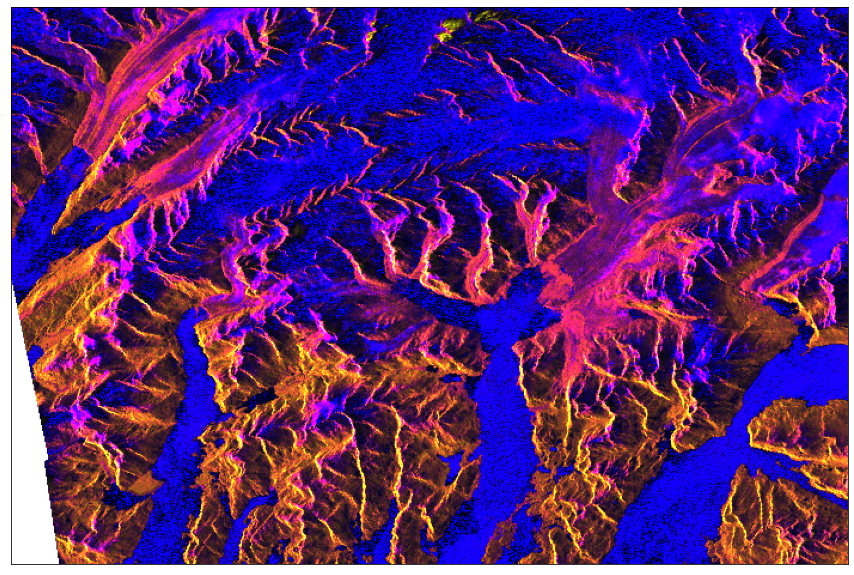
Let’s also check a Sentinel-3 OLCI data collection:
[8]:
DataCollection.SENTINEL3_OLCI
[8]:
<DataCollection.SENTINEL3_OLCI: DataCollectionDefinition(
api_id: sentinel-3-olci
catalog_id: sentinel-3-olci
wfs_id: DSS8
service_url: https://creodias.sentinel-hub.com
collection_type: Sentinel-3
sensor_type: OLCI
processing_level: L1B
bands: ('B01', 'B02', 'B03', 'B04', 'B05', 'B06', 'B07', 'B08', 'B09', 'B10', 'B11', 'B12', 'B13', 'B14', 'B15', 'B16', 'B17', 'B18', 'B19', 'B20', 'B21')
is_timeless: False
has_cloud_coverage: False
)>
Notice that its definition contains a different service_url parameter. Its value is used to override a default sh_base_url defined in config object.
[9]:
evalscript = """
//VERSION=3
return [B08, B06, B04]
"""
time_interval = "2020-07-06", "2020-07-07"
request = SentinelHubRequest(
evalscript=evalscript,
input_data=[
SentinelHubRequest.input_data(
data_collection=DataCollection.SENTINEL3_OLCI,
time_interval=time_interval,
)
],
responses=[SentinelHubRequest.output_response("default", MimeType.PNG)],
bbox=glacier_bbox,
size=glacier_size,
config=config,
)
image = request.get_data()[0]
plot_image(image, factor=1.5 / 255, clip_range=(0, 1))
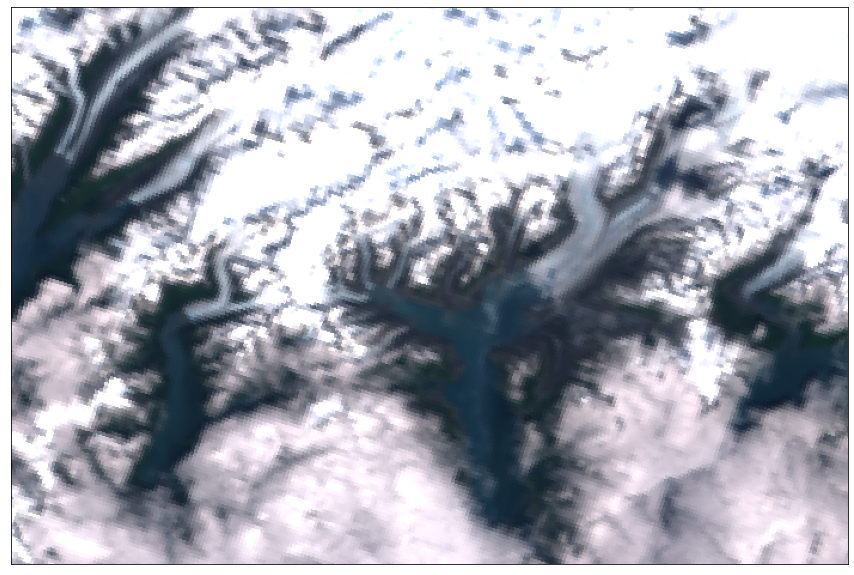
Define a new data collection
To support a growing number of new data collections it is possible to define a new data collection. A data collection definition supports many parameters, but it is only required to fill those parameters that will actually be required in the code.
[10]:
DataCollection.define(
name="CUSTOM_SENTINEL1",
api_id="S1GRD",
catalog_id="sentinel-1-grd",
wfs_id="DSS3",
service_url="https://services.sentinel-hub.com",
collection_type="Sentinel-1",
sensor_type="C-SAR",
processing_level="GRD",
swath_mode="IW",
polarization="SV",
resolution="HIGH",
orbit_direction="ASCENDING",
timeliness="NRT10m",
bands=("VV",),
is_timeless=False,
)
[10]:
<DataCollection.CUSTOM_SENTINEL1: DataCollectionDefinition(
api_id: S1GRD
catalog_id: sentinel-1-grd
wfs_id: DSS3
service_url: https://services.sentinel-hub.com
collection_type: Sentinel-1
sensor_type: C-SAR
processing_level: GRD
swath_mode: IW
polarization: SV
resolution: HIGH
orbit_direction: ASCENDING
timeliness: NRT10m
bands: ('VV',)
is_timeless: False
has_cloud_coverage: False
)>
The most common examples of user-defined data collections are “bring your own data” (BYOC) data collections, where users can bring their own data and access it with Sentinel Hub service. To be able to do that you will need to prepare a few things. Roughly speaking, these are the following (find all details here):
Convert your data to Cloud Optimized GeoTiff (COG) format. Store it in an AWS S3 bucket and allow SH to access it.
Create a collection in SH, which points to the S3 bucket. Within the collection, ingest the tiles from the bucket.
To demonstrate this, we have prepared an example collection with a Slovenian land-cover reference map. It is available with the collection id at 7453e962-0ee5-4f74-8227-89759fbe9ba9.
Now we can define a new BYOC data collection either with DataCollection.define method or with a more convenient DataCollection.define_byoc method:
[11]:
collection_id = "7453e962-0ee5-4f74-8227-89759fbe9ba9"
byoc = DataCollection.define_byoc(collection_id, name="SLOVENIA_LAND_COVER", is_timeless=True)
byoc
[11]:
<DataCollection.SLOVENIA_LAND_COVER: DataCollectionDefinition(
api_id: byoc-7453e962-0ee5-4f74-8227-89759fbe9ba9
catalog_id: byoc-7453e962-0ee5-4f74-8227-89759fbe9ba9
wfs_id: byoc-7453e962-0ee5-4f74-8227-89759fbe9ba9
collection_type: BYOC
collection_id: 7453e962-0ee5-4f74-8227-89759fbe9ba9
is_timeless: True
has_cloud_coverage: False
)>
Let’s load data for defined BYOC data collection:
[12]:
from sentinelhub import bbox_to_dimensions
slovenia_bbox = BBox((13.353882, 45.402307, 16.644287, 46.908998), crs=CRS.WGS84)
slovenia_size = bbox_to_dimensions(slovenia_bbox, resolution=240)
evalscript_byoc = """
//VERSION=3
function setup() {
return {
input: ["lulc_reference"],
output: { bands: 3 }
};
}
var colorDict = {
0: [255/255, 255/255, 255/255],
1: [255/255, 255/255, 0/255],
2: [5/255, 73/255, 7/255],
3: [255/255, 165/255, 0/255],
4: [128/255, 96/255, 0/255],
5: [6/255, 154/255, 243/255],
6: [149/255, 208/255, 252/255],
7: [150/255, 123/255, 182/255],
8: [220/255, 20/255, 60/255],
9: [166/255, 166/255, 166/255],
10: [0/255, 0/255, 0/255]
}
function evaluatePixel(sample) {
return colorDict[sample.lulc_reference];
}
"""
byoc_request = SentinelHubRequest(
evalscript=evalscript_byoc,
input_data=[SentinelHubRequest.input_data(data_collection=byoc)],
responses=[SentinelHubRequest.output_response("default", MimeType.TIFF)],
bbox=slovenia_bbox,
size=slovenia_size,
config=config,
)
byoc_data = byoc_request.get_data()
plot_image(byoc_data[0], factor=1 / 255)
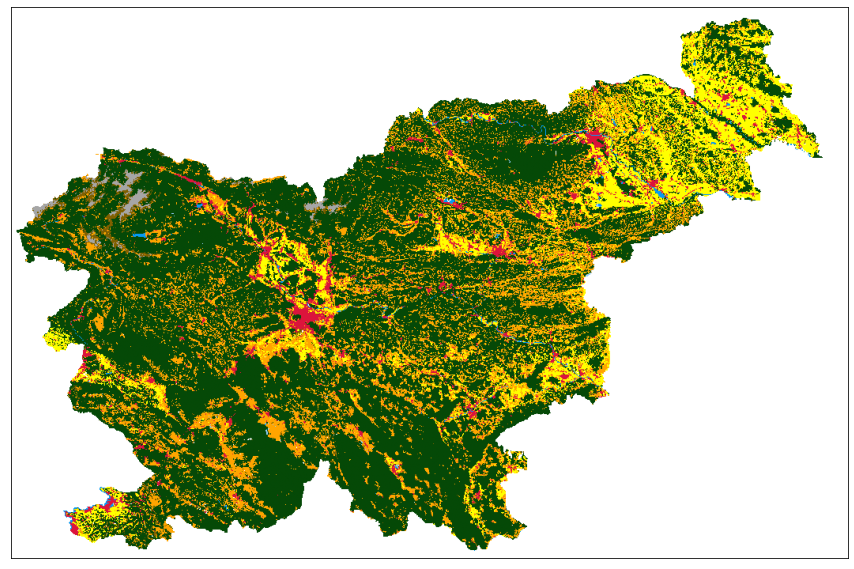
Another option is to take an existing data collection and create a new data collection from it. The following will create a data collection with a different service_url parameter. Instead of collecting data from a default Sentinel Hub deployment it will collect data from MUNDI deployment.
[13]:
s2_l2a_mundi = DataCollection.define_from(
DataCollection.SENTINEL2_L2A, "SENTINEL2_L2A_MUNDI", service_url="https://shservices.mundiwebservices.com"
)
s2_l2a_mundi
[13]:
<DataCollection.SENTINEL2_L2A_MUNDI: DataCollectionDefinition(
api_id: sentinel-2-l2a
catalog_id: sentinel-2-l2a
wfs_id: DSS2
service_url: https://shservices.mundiwebservices.com
collection_type: Sentinel-2
sensor_type: MSI
processing_level: L2A
bands: ('B01', 'B02', 'B03', 'B04', 'B05', 'B06', 'B07', 'B08', 'B8A', 'B09', 'B11', 'B12')
is_timeless: False
has_cloud_coverage: True
)>
[14]:
from sentinelhub import MosaickingOrder
time_interval = "2020-06-01", "2020-07-01"
evalscript = """
//VERSION=3
function setup() {
return {
input: [{
bands: ["B02", "B03", "B04"]
}],
output: {
bands: 3
}
};
}
function evaluatePixel(sample) {
return [sample.B04, sample.B03, sample.B02];
}
"""
request = SentinelHubRequest(
evalscript=evalscript,
input_data=[
SentinelHubRequest.input_data(
data_collection=s2_l2a_mundi, time_interval=time_interval, mosaicking_order=MosaickingOrder.LEAST_CC
)
],
responses=[SentinelHubRequest.output_response("default", MimeType.PNG)],
bbox=slovenia_bbox,
size=slovenia_size,
config=config,
)
image = request.get_data()[0]
print("Request URL:", request.download_list[0].url)
plot_image(image, factor=3.5 / 255, clip_range=(0, 1))
Request URL: https://shservices.mundiwebservices.com/api/v1/process
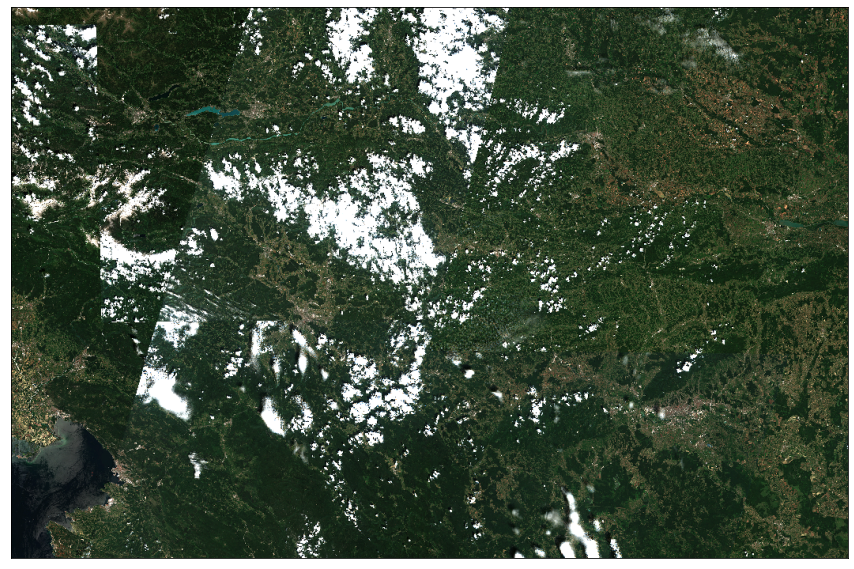
Data fusion
An advanced way of using data collections is to define an evalscript that joins together data from different collections and downloads only the results. This is called data fusion and is described in detail in Sentinel Hub documentation.
In this example we will do a data fusion that uses Sentinel-2 data to pan-sharpen Landsat-8 data.
[15]:
evalscript = """
//VERSION=3
function setup() {
return {
input: [{
datasource: "ls8",
bands: ["B02", "B03", "B04", "B05", "B08"]
},
{
datasource: "l2a",
bands: ["B02", "B03", "B04", "B08", "B11"]
}
],
output: [{
bands: 3
}]
}
}
let minVal = 0.0
let maxVal = 0.4
let viz = new DefaultVisualizer(minVal, maxVal)
function evaluatePixel(samples, inputData, inputMetadata, customData, outputMetadata) {
var sample = samples.ls8[0]
var sample2 = samples.l2a[0]
// Use weighted arithmetic average of S2.B02 - S2.B04 for pan-sharpening
let sudoPanW3 = (sample.B04 + sample.B03 + sample.B02) / 3
let s2PanR3 = (sample2.B04 + sample2.B03 + sample2.B02) / 3
let s2ratioWR3 = s2PanR3 / sudoPanW3
let val = [sample.B04 * s2ratioWR3, sample.B03 * s2ratioWR3, sample.B02 * s2ratioWR3]
return viz.processList(val)
}
"""
request = SentinelHubRequest(
evalscript=evalscript,
input_data=[
SentinelHubRequest.input_data(
data_collection=DataCollection.LANDSAT_OT_L1,
identifier="ls8", # has to match Landsat input datasource id in evalscript
time_interval=("2020-05-21", "2020-05-23"),
),
SentinelHubRequest.input_data(
data_collection=DataCollection.SENTINEL2_L2A,
identifier="l2a", # has to match Sentinel input datasource id in evalscript
time_interval=("2020-05-21", "2020-05-23"),
),
],
responses=[SentinelHubRequest.output_response("default", MimeType.PNG)],
bbox=BBox((2.142, 41.378, 2.208, 41.408), CRS.WGS84),
size=(1024, 1024),
config=config,
)
image = request.get_data()[0]
plot_image(image, factor=3.5 / 255, clip_range=(0, 1))
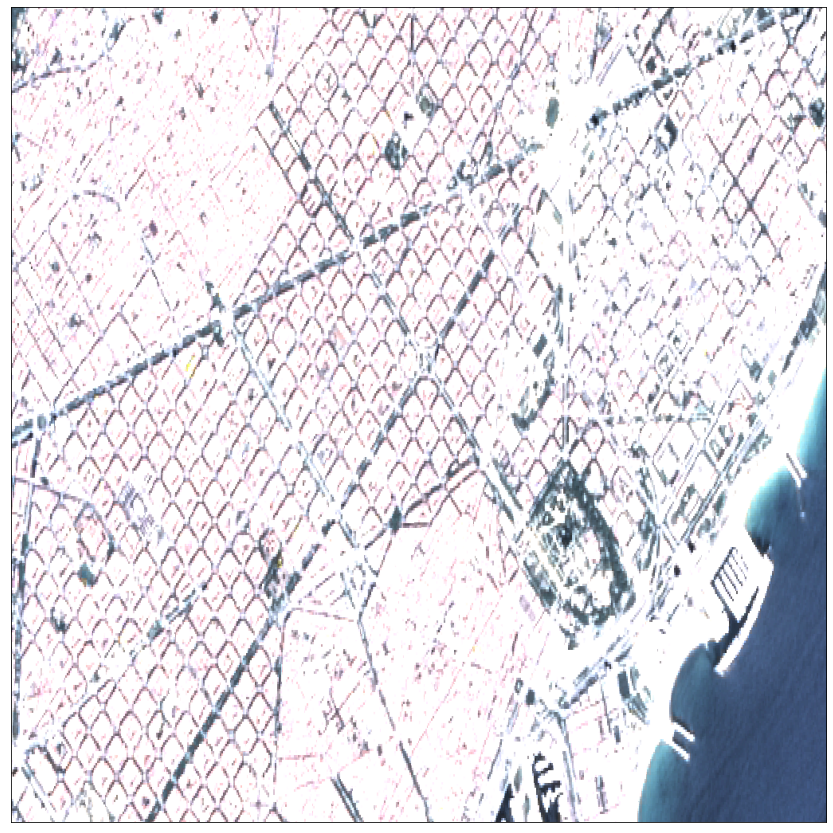
Notice that the main difference in defining a SentinelHubRequest object is that for data fusion we had to define identifier parameters. They are used to match request collections with collections defined in the evalscript.
In this case, DataCollection objects for Sentinel-2 and Landsat-8 were defined with different service URLs. Because of that, the base URL from a configuration object was taken to decide, to which service the request should be sent.
[16]:
print("Default Landsat-8 collection base URL:", DataCollection.LANDSAT_OT_L1.service_url)
print("Default Sentinel-2 collection base URL:", DataCollection.SENTINEL2_L2A.service_url)
print("Base URL from config breaks the tie:", config.sh_base_url)
print("Request URL:", request.download_list[0].url)
Default Landsat-8 collection base URL: https://services-uswest2.sentinel-hub.com
Default Sentinel-2 collection base URL: https://services.sentinel-hub.com
Base URL from config breaks the tie: https://services.sentinel-hub.com
Request URL: https://services.sentinel-hub.com/api/v1/process